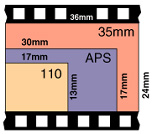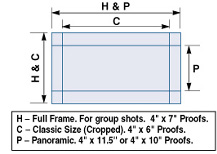
The Advanced Photo System

The Advanced Photo System

You've seen the ads on television and read the articles in photographic magazines. Perhaps you already own an Advanced Photo SystemTM camera. You may wonder what the "truth" is about the Advanced Photo System and what we, as a top-quality laboratory, think of it.
The key to really high quality Advanced Photo System photographs is in the processing. With our processing and printing, the Advanced Photo System will give you the vibrant photographs you see advertised on TV. You'll also be able to take advantage of a pricing schedule that may save you a lot of money. While most stores and photo labs take an a la carte approach (where you pay so much for film processing and an index print plus so much more for each of the three print formats), we have a single price for each roll size (15, 25 or 40 frames). So, you can shoot whichever of the three APS print formats you want and not get "sticker shock"...and a huge bill...when you receive your prints and find that you'd taken too many pictures on the very expensive panoramic (P) setting!
Many of our customers are asking which camera system we'd recommend. The answer is "It depends on your individual needs and priorities."
Perhaps a little history of the Advanced Photo System and a comparison of its features to 35mm will help you in your decision.
The Advanced Photo System was designed by a consortium of the major film and camera manufacturers to provide a simpler way for amateur photographers to take pictures. The manufacturers' market research indicated that many people were having difficulty using and loading even relatively simple 35mm cameras. While loading problems rarely affected advanced amateurs or professionals, some "non-photographs" were losing pictures due to their inability to load even the most "automatic" 35mm cameras. As a result, some people were not taking pictures.
The largest film manufacturers (Kodak and Fuji) reacted by joining with
the leading camera makers (Canon, Minolta and Nikon) to create a new film/camera
format that would appeal to the mass market and, hopefully, generate renewed
interest in picture taking. They told their engineers that the new format
had to 1) be simple to use, with drop-in loading like the old 110 format,
2) have a lot of convenience features that would stimulate camera sales
and 3) be small enough to be carried and used by anyone.
Darned if we know! But consider this. The research and development, plant expansions, and advertising required to launch the film format cost the "majors" hundreds of millions of dollars. New film emulsions and packaging had to be designed as well as whole new camera lines. If you were the person in charge of marketing would you like to go to the presidents of the various companies involved and say that you'd be calling the film "240" (its correct technical name)? Not if you wanted to keep your job!
In an age of hype, the job of a marketing department is not just to sell...but
to oversell. And, considering the vast effort and tremendous costs that
went into designing the Advanced Photo System, we certainly wouldn't fault
the marketing gurus for doing their jobs.
Not really. It does have a few more "bells and whistles" (i.e. varying print formats, drop-in loading). Properly processed and printed APS negatives will give you proofs and small enlargements (up to 8"x12") that are comparable to ones from 35mm negs. But, we certainly wouldn't suggest you throw out a perfectly good 35mm camera to buy an Advanced Photo System model. Contrary to the impression you might be getting from overzealous (and somewhat irresponsible) TV ads, 35mm is far from dead or obsolete. If you're planning to purchase a new camera and trying to decide between the two systems, we'd suggest you look at the following comparison.
 An Advanced Photo System camera may not be
your best choice if you want big enlargements. That's because
the images on APS negatives are 59% of the size of a 35mm frame. So, APS
negatives may not enlarge with the same level of quality as 35mm pictures
taken on the same grade of film. (New 35mm films being introduced by Kodak
and Fuji have the same grain and dye structure as the "advanced"
film emulsions used for Advanced Photo System films.)
An Advanced Photo System camera may not be
your best choice if you want big enlargements. That's because
the images on APS negatives are 59% of the size of a 35mm frame. So, APS
negatives may not enlarge with the same level of quality as 35mm pictures
taken on the same grade of film. (New 35mm films being introduced by Kodak
and Fuji have the same grain and dye structure as the "advanced"
film emulsions used for Advanced Photo System films.) 
This is a situation where any decision you make will be a good one. Both 35mm and Advanced Photo System cameras and film will produce excellent quality prints. On standard proofing sizes you'll find it difficult to tell the difference between pictures taken with Advanced Photo System cameras and 35mm models of the same quality level (SLR vs. SLR or point-and-shoot vs. point-and-shoot). So, if you don't need big enlargements...or want to use our slide & print, Picture CD or Photo CD services...there is no reason not to purchase an Advanced Photo System camera. Your decision should be based on your needs and how you view the advantages...and value...of each system.
As we see it, the major criteria for deciding which camera to buy are:
Whichever camera you choose, you can trust Dale Laboratories to give you the best possible pictures! We hope that this comparison has been useful.
To receive postpaid film processing mailers... Click here.
For an easy-to-use APS film processing order form... Click here.